The Ultimate Guide to Umbraco SEO: Boost Your Website's Visibility
Introduction
What is Umbraco SEO, and why is it Crucial?
For websites powered by Umbraco CMS, effective SEO can mean the difference between online shadow and consistent growth. While Umbraco offers powerful content management capabilities, its unique architecture presents both opportunities and challenges for search optimization that standard SEO guides don't address.
This comprehensive guide is designed specifically for marketers, businesses, and developers working with Umbraco who want to maximize their organic traffic and visibility. You'll discover how to leverage Umbraco's built-in SEO features, from its flexible URL structure to its content modeling capabilities, while avoiding common challenges specific to this CMS.
From essential on-page optimization techniques to advanced technical strategies like structured data implementation and AI-ready content, we'll provide actionable, Umbraco-specific advice for every aspect of SEO. You'll also learn which Umbraco plugins deliver the best SEO benefits and how external tools can help you achieve comprehensive optimization.
By the time you finish reading this guide, you'll understand exactly how to make your Umbraco website really stand out in search results. You'll learn the steps and find the resources you need to bring more of the right kind of visitors to your site and make their experience much better.
Chapter 1: Mastering On-Page SEO in Umbraco
Understanding On-Page SEO Fundamentals
Have you ever wondered why some Umbraco websites rank higher than others despite having similar content? The answer often lies in the quality of on-page SEO implementation.
On-page SEO creates the foundation of search engine visibility for your Umbraco website. It involves optimizing individual pages to rank higher and attract relevant traffic from search engines. This optimization covers content quality, metadata configuration, strategic internal linking, and user experience improvement, all crucial factors in how search engines interpret and display your website.
Unlike plug-and-play CMS platforms, Umbraco requires more deliberate development for SEO readiness. While its interface is user-friendly, many SEO-critical features such as title tags, meta descriptions, and custom URL slugs require coding or the integration of a starter kit.
The Critical Role of On-Page SEO
On-page SEO directly impacts:
- Search Rankings: Well-optimized pages have a better chance of ranking higher in search results
- User Experience: Clear structure and relevant content improve how visitors interact with your site
- Conversion Rates: Properly optimized pages guide users toward your desired actions
- Crawlability: Helps search engines understand your content structure and hierarchy
In this chapter, you'll discover how to leverage Umbraco's powerful tools to structure, elevate, and refine your on-page SEO for maximum impact.
Optimizing Key On-Page Elements in Umbraco
Page Title Tags
Why Title Tags Matter
Title tags are among the most influential on-page SEO elements. They define your page's title in search engine results pages (SERPs) and significantly impact click-through rates (CTR).
An effective title tag should:
- Contain 50-60 characters to avoid truncation in search results
- Naturally incorporate your main keyword (preferably near the beginning)
- Use compelling language that encourages clicks.
- Accurately represent the page content

Best Practices for Title Tags in Umbraco
How to Implement in Umbraco:
Umbraco does not support custom title tags out-of-the-box. You need to:
- Extend your document type with a title tag property
- Modify your master template to render this property in the HTML <title> element
Alternatively, consider using a starter kit, like SEOToolKit, or a visual website builder with SEO features out-of-the-box, like ByteEditor.
Examples:
Poor: "Umbraco SEO | SEO for Umbraco | Best SEO Guide for Umbraco"
Why it's ineffective: It's too repetitive, keyword stuffing that can trigger search engine penalties.
Better: "The Ultimate Umbraco SEO Guide: Boost Your Website's Rankings"
Why it works: It is Clear, engaging, contains the main keyword naturally, and communicates value.
Page Meta Descriptions
How to Optimize Meta Descriptions
While meta descriptions don't directly impact rankings, they serve as your page's advertisement in search results and significantly influence users click through to your site.
For effective meta descriptions:
- Keep them between 140 and 160 characters to prevent truncation
- Include your primary keyword naturally
- Use action-oriented language with a clear value proposition
- Include a call to action when appropriate
Setting Meta Descriptions in Umbraco
Similar to title tags, Umbraco doesn't provide meta description fields by default.
- Add a custom property to your Document Types
- Update your templates to render this metadata
- Refer to the Umbraco documentation for detailed steps on creating and using templates
Alternatively, starter kits with built-in SEO fields can simplify this process.
SEO-friendly Page URL
Umbraco automatically generates URLs based on the page name, ensuring clean and readable slugs. However, you can customize URLs with a reserved umbracoUrlName Document Type Property.
Customize a page URL in Umbraco backoffice:
Step 1: Add the umbracoUrlName Property to the Document Type:
In the Umbraco Backoffice, go to the Settings section, select the Document Type you want to edit, then add a new property.
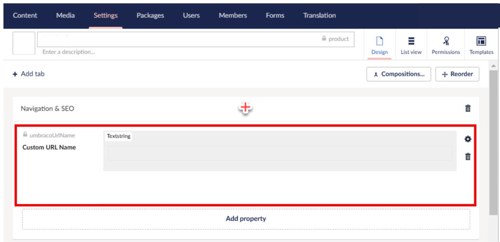
Step 2: Apply umbracoUrlName to a Content Node:
Go to Umbraco Backoffice, then open Content, select the node you want to edit, locate the Custom URL Name, and enter your preferred URL slug, then save and publish the page.
Step 3: Verify URL:
Open your website and access the new URL, check for errors in loading or content display.
Ensure that your URLs are concise, include relevant keywords, and avoid unnecessary parameters or session IDs.
Header Tags (H1-H6): Structuring Content for SEO and Readability
Why Header Tags Matter
Header tags create a hierarchical structure that helps both search engines and users understand your content organization.
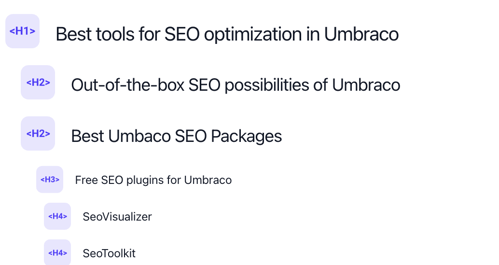
For optimal header structure:
- Use a single H1 per page—this should contain your primary keyword and serve as the main title
- Implement H2s for major sections, incorporating secondary keywords where natural
- Utilize H3s for subtopics within sections
- Ensure headers are descriptive and keyword-relevant while maintaining natural language
- Maintain a logical hierarchy (H1 → H2 → H3, etc.)
How to Set Headers in Umbraco
Umbraco's Rich Text Editor makes implementing a proper header structure straightforward:
- Select the text you want to format as a header
- Use the formatting dropdown in the Rich Text Editor
- Choose the appropriate header level (H1-H6)
- Ensure your headers follow a logical sequence and contain relevant keywords
For more complex layouts, consider using Block List or Block Grid editors, which offer greater control over content structure.
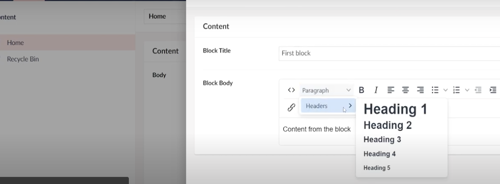
Pro Tip: Audit your existing content using plugins and tools, like ByteEditor’s SEO features, to ensure consistent header usage across your site. An inconsistent header structure can confuse search engines and impact rankings.
Content Optimization: Writing High-Quality, Keyword-Rich Content
The Importance of Keyword Research
Before creating content, thorough keyword research is essential to understand user search intent and identify valuable targeting opportunities.
Effective keyword research for Umbraco SEO content involves:
-
Identifying seed keywords related to your topic or industry
-
Expanding your list using keyword research tools like Google Keyword Planner, Ahrefs, and Moz Keyword Explorer
-
Analyzing search intent behind keywords:
- Informational (seeking knowledge)
- Navigational (looking for a specific site)
- Commercial (researching products/services)
- Transactional (ready to purchase)
4. Evaluating competition and search volume:
- Target a mix of high-volume competitive terms and lower-volume niche keywords
- Look for "keyword gaps" that your competitors haven't covered
Why Content Matters for SEO
Content quality remains the base of effective SEO. Google's algorithms, particularly after the Helpful Content Update, prioritize content that demonstrates Experience, Expertise, Authority, and Trustworthiness (E-E-A-T).
How to Create SEO-optimized content for Umbraco website
Follow E-E-A-T principles
- Demonstrate expertise on the topic
- Provide authoritative information with credible sources
- Build trustworthiness through accurate, helpful content
- Share experience-based insights when applicable
Implement strategic keyword usage
- Place your primary keyword in the first 100 words
- Use secondary keywords throughout the content naturally
- Include LSI (Latent Semantic Indexing) keywords related to your topic
- Avoid keyword stuffing, which can trigger penalties
Create valuable, well-structured content
- Answer user questions comprehensively
- Use short paragraphs
- Include bullet points and numbered lists for scannability
- Bold important information for emphasis
- Aim for appropriate length based on topic complexity
How to Optimize Content in Umbraco
Umbraco's backoffice provides an intuitive platform for creating SEO-optimized content:
- Use Umbraco's built-in rich text editor to structure content with proper headings, bold text, and lists/bullet points
- Focus on topic comprehensiveness rather than keyword density
- Break content into logical sections with descriptive subheadings
- Utilize the preview function to ensure content readability
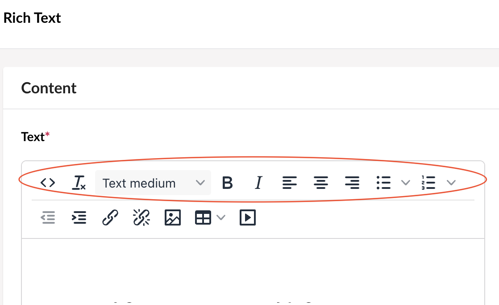
Image Optimization: Enhancing Visual Elements for SEO
Why Image SEO Is Important
Optimized images improve user experience while contributing to faster page loading times—a critical ranking factor. According to Google, as page load time increases from 1 to 10 seconds, the probability of bounce increases by 123%.
For comprehensive image optimization in Umbraco:
Technical optimization:
Slow-loading images hurt both user experience and SEO rankings. Here's how to handle it in Umbraco:
- Use WebP or AVIF formats: These offer better compression than JPEG or PNG. Umbraco supports these if configured correctly via ImageSharp
- Enable image cropping/resizing using Umbraco’s Image Cropper to serve responsive images tailored to each device
- Leverage lazy loading: Implement lazy loading either via a custom Razor view component or JavaScript, or use a plugin, like Slimsy
SEO Optimization:
Optimized images can appear in Google Images and enhance accessibility:
- Rename image files before uploading (e.g., seo-audit-umbraco.jpg instead of IMG_1032.jpg)
- Add descriptive alt text for each image, explaining the content clearly with relevant keywords. This must be implemented in your Razor templates
- Use captions to give additional context
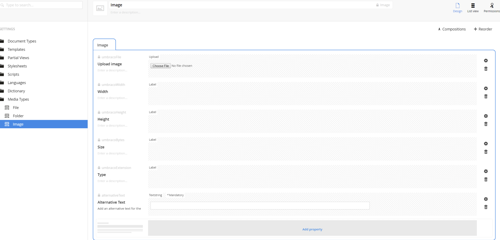
Internal Linking: Boosting Authority and Navigation
Why Internal Linking Matters
Strategic internal linking distributes page authority throughout your site, establishes content hierarchy, and improves user navigation.
For effective internal linking in Umbraco:
- Link to relevant, related content that provides additional value
- Use descriptive anchor text containing keywords (e.g., "Umbraco SEO guide" instead of "click here"
- Ensure important pages receive more internal links to boost their authority
- Create a logical site structure that helps users and search engines navigate your content
- Regularly audit internal links to identify and fix broken or outdated URLs
How to Add Internal Links in Umbraco
How to Manage Internal Links in Umbraco
- Rich Text Editor (RTE): Use the built-in link picker to select internal content. This ensures links remain valid even if the content node is renamed or moved
- Block List/Grid Editors: If using block editors, use a Link Picker property editor to define internal links at the block level
- Custom Partials: For advanced use cases like dynamic “related articles” or product links, build reusable Razor Partials that auto-generate internal links based on tags or categories

Conclusion: Building a Solid On-Page SEO Foundation in Umbraco
On-page SEO in Umbraco is about leveraging the platform's flexibility to create a well-structured, user-focused website that search engines can easily understand and rank appropriately. By optimizing titles, meta descriptions, headers, content, images, and internal links, you create an SEO-friendly and user-friendly website that stands out in search results.
Remember that on-page SEO is not a one-time task but an ongoing process of refinement and improvement. Regularly audit your site's on-page elements, analyze performance data, and adjust your strategy based on results.
Key Takeaways
- Umbraco provides a flexible framework for implementing comprehensive on-page SEO strategies
- Proper metadata configuration significantly impacts click-through rates from search results
- Content structure and quality remain fundamental ranking factors
- Image optimization improves both user experience and page performance
- Strategic internal linking distributes authority and enhances site navigation
Now that you've discovered the fundamentals of on-page SEO in Umbraco, it's time to put these strategies into action.
-
Audit your current pages and identify areas for improvement.
Ready to know more?
In the next chapter, we’ll dive into advanced Umbraco technical SEO strategies, including URL structure optimization, XML sitemaps, and robots.txt configuration.
Chapter 2: Technical SEO for a Healthy Umbraco Website
Why Technical SEO Matters
Technical SEO focuses on optimizing a website’s infrastructure to ensure search engines can crawl, index, and rank it efficiently. It involves improving site architecture, performance, and accessibility.
A well-optimized technical foundation enhances user experience, improves rankings, and ensures search engines can effectively interpret your content.
Umbraco's flexible architecture allows for extensive customization and technical enhancements directly within the CMS, enabling advanced optimizations without extensive development work.
Indexing & Crawlability: Helping Search Engines Find Your Content
If search engines can't properly crawl and index your pages, even perfectly optimized content won't rank. Ensuring accessibility for search engine bots is crucial.
Enhancing Crawler Access in Umbraco
To unlock your website’s potential, you must allow search engines to crawl and index your pages properly. Umbraco provides flexible tools to ensure seamless accessibility for search engine bots.
Creating and Submitting an XML Sitemap
-
Generate a Sitemap: Use Umbraco packages like SEO Toolkit or create one via custom code.
-
Prioritize Key Pages: Highlight high-value content such as product pages, blog posts, and landing pages. Group them logically using your site's architecture.
-
Submit in Google Search Console: Monitor indexing performance regularly.
Customizing Robots.txt
- Create a custom robots.txt file within Umbraco, manually upload the file to the site’s root, or configure it via code/plugins.
- Use appropriate directives like disallow, allow, to control what crawlers can or cannot access.
- Add a reference to your sitemap for better visibility.


Implementing and Monitoring Canonical URLs
- Apply canonical tags, explained here, eliminate duplicate content issues
- Configure pagination with self-referencing canonical
- Periodically audit canonical tags for errors using tools like Screaming Frog or Ahrefs
Fixing Crawl Errors in Google Search Console
- Monitor Errors: Regularly check for crawl issues in Google Search Console
- Resolve 404 Errors: Use Umbraco's tools like, URL Tracker, to manage and redirect broken links
- Create a scheduled audit process to identify and fix recurring crawl issues
Page Speed: Boosting Performance for Better Rankings
Core Web Vitals to Focus On
Google has confirmed that page speed is a ranking factor, particularly for mobile searches. Fast-loading websites provide a better user experience, leading to lower bounce rates, higher conversion rates, and improved crawl efficiency.
Google PageSpeed Insights offers a comprehensive way to analyze your Umbraco site's performance on both mobile and desktop devices.
Run regular audits by entering your URL at pagespeed.web.dev to receive detailed scores on Core Web Vitals and other performance metrics.
Pay special attention to Largest Contentful Paint (LCP), First Input Delay (FID), and Cumulative Layout Shift (CLS) scores, as these Core Web Vitals directly impact your search rankings.
For Umbraco sites, focus on server-side rendering optimizations and efficient asset delivery, which often appear as high-priority opportunities in the PageSpeed report.
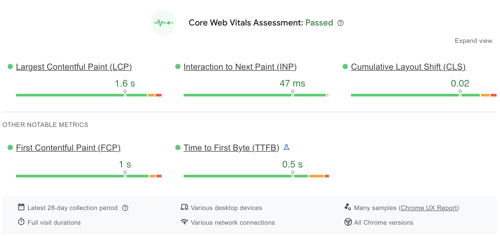
How to Optimize Page Speed in Umbraco
Optimize Images.
Minify and Optimize Front-End Code
- Enable CSS/JavaScript minification in Umbraco (Bundling & Minification for JavaScript and CSS)
- Remove unused CSS and add async or defer attributes for script loading where applicable
Leverage Browser Caching and CDNs
- Configure proper caching headers (Umbraco Imaging Settings)
- Use CDNs like Cloudflare for global content delivery
Reduce Server Response Time (TTFB)
- Choose optimized hosting solutions tailored to Umbraco
- Implement Partial View Caching: Use Cached Partial for re-usable page widgets
- Content and media cleanup: remove unused data and regularly check for database fragmentation
- For high-load websites: consider using horizontal scaling and setting up distributed server-side cache
Mobile Optimization: Creating a Seamless Experience
With Google's Mobile-First Indexing, your site's mobile version is now the primary version for indexing and ranking.
How to Optimize Umbraco Sites for Mobile
1.Implement Responsive Design
- Choose mobile-friendly templates and layouts
- Test across various devices using Google's Mobile-Friendly Test
- Optimize the viewport configuration for better scaling
2. Optimize Touch Elements and Interactions
- Ensure touch targets are at least 44x44 pixels for better usability
- Optimize typography for mobile readability (minimum 16px font size)
- Simplify forms for mobile users to enhance the user experience
Managing Redirects & HTTPS in Umbraco
Redirects and security protocols play a vital role in maintaining a healthy SEO strategy. Proper implementation prevents broken links, maintains link equity, and ensures secure connections for users and search engines alike.
Implementing Redirects in Umbraco
Build-in URL Tracker
Umbraco automatically creates 301 permanent redirects when you rename or move content, this action is managed by the Build-in URL Tracker.
Custom Redirects using Plugins
To configure both 301 permanent redirects and 302 temporary redirects you can use a plugin, such as URlTracker, or if you are using ByteEditor this feature is already allowing you to manage redirects directly from backoffice interface.
Enforcing HTTPS for Secure Browsing
- SSL Certificate: Obtain and install a valid certificate
- Umbraco Configuration: Set useHttps to true in configuration (HTTPS Setup Guide)
- Force Redirects: Redirect HTTP traffic to HTTPS
- Fix Mixed Content: Use Chrome DevTools to identify insecure elements
Structured Data & Schema Markup: Enhancing Search Visibility
Structured data provides explicit clues about page content to search engines, enabling rich results like featured snippets, knowledge panels, and enhanced listings.
How to add Schema Markup in Umbraco
There are two options in how to add schema to your Umbraco Website:
1. Use a Plugin:
Umbraco plugins (starter packages), like ByteEditor, include built-in schema support and generate structured data automatically.
2. Use Custom Code:
Choose Your Schema Type
Choose what structured data you need: Product, FAQ, LocalBusiness, BlogPosting, etc. Use Schema.org for reference.
Generate the Markup
Use a tool like Merkle’s Schema Generator to create JSON-LD for the selected Schema Type.
Add Schema to your page through Umbraco Templates
You have 2 basic options:
Static values and data: add the generated schema markup directly to a template.
Dynamic structured data from Umbraco content: add generated schema markup to a template and pull values dynamically from Model and Document Type properties.
Check this guide if you’d like to learn more about custom code implementation options.
Validation: After implementation with Umbraco plugin or custom code, use a tool like Rich Results Test to check your pages and ensure your structure data is working correctly.
Common Technical SEO Issues in Umbraco and How to Fix Them
|
Issue |
Diagnosis |
Solutions |
|
Slow Page Loading Speed |
Use PageSpeed Insights to identify bottlenecks |
Optimize images, implement caching, minify code, and use a CDN |
|
Pages Not Being Indexed |
Check Google Search Console's Coverage report |
Update robots.txt, remove noindex tags, submit sitemap, and add internal links |
|
Mobile Usability Problems |
Review the Mobile Usability report in Search Console |
Implement responsive design, fix touch elements, and ensure readable text |
|
Duplicate Content |
Check for multiple URLs serving identical content |
Implement canonical tags, use redirects, and handle URL parameters properly |
Conclusion: Building a Solid Technical Foundation in Umbraco
Technical SEO is an ongoing process of monitoring, testing, and refining. Regular audits using tools like Google Search Console, PageSpeed Insights, and Screaming Frog will help you identify new opportunities and address emerging issues before they impact your rankings.
Key Takeaways:
- Logical site structure improves user experience and search engine understanding.
- Page speed optimization directly impacts rankings and engagement.
- A mobile-friendly design is essential with mobile-first indexing.
- Proper crawl management ensures search engines find your important content.
- Structured data enhances search visibility through rich results.
Start optimizing your Umbraco site now by running a technical SEO audit and implementing these best practices.
Small changes lead to big results in search visibility and user experience.
Chapter 3: Off-Page SEO and Building Authority for Your Umbraco Site
What is Off-page SEO
Off-page SEO is everything you do outside of your website to impact your rankings in search engine results pages (SERPs). While on-page SEO is about optimising elements within your site, off-page SEO refers to building relationships and promoting your site and reputation across the web.
Why off-page SEO is important:
- Build Credibility: High-quality backlinks from good sites tell search engines your content is valuable and trustworthy.
- Increase Visibility: Good off-page strategies can get you higher rankings and more organic traffic.
- Brand Recognition: Engage with your audience across platforms and build brand awareness and loyalty.
Link Building Strategies for Umbraco Websites
Building a solid backlink profile is the center of off-page SEO.
Treat link building as a long-term investment, you can set monthly goals, track progress, and stay consistent. A structured plan helps your Umbraco website gradually boost its Domain Rating (DR) and improve ranking.
Earning High-Quality Backlinks
Focus on getting backlinks from authoritative and relevant sites. Quality over quantity is always the key in link building.
- Create Shareable Content: Create informative and engaging content that naturally gets other sites to link to it.
- Industry Forums: Participate in forums related to your niche, provide value, and link back to relevant content on your site.

Guest Blogging Opportunities
Contribute to reputable blogs in your industry. This positions you as an authority and gives you opportunities to link back to your Umbraco site.
- Target Blogs: Research blogs that are relevant to your niche and accept guest posts.
- Quality Content: Ensure your guest posts are well-researched, informative, and provide value to the host blog’s audience.
Directory Submissions
Submitting your site to directories can be beneficial if done right.
- Choose Reputable Directories: Focus on directories that are relevant to your industry and have a good reputation. For example, Umbraco sites can benefit from listings on platforms like Clutch or global directories like G2.
- Avoid Spammy Directories: Submitting to low-quality directories can harm your SEO. Quality over quantity.
Grow your Umbraco site’s authority by earning high-quality backlinks, contributing guest posts, and securing reputable directory listings. Start with one strategy and scale up for lasting SEO success!
The Role of Social Media in Off-Page SEO
Although social signals don’t directly influence rankings, social media plays a crucial role in driving traffic and visibility.
Strengthen your content’s presence by making it visually compelling and optimized for sharing:
Properly implementing Open Graph tags ensures your content looks appealing when shared on social platforms.
Share Valuable Content
Distribute your blogs, case studies, and guides across platforms like LinkedIn, Twitter, and Instagram.
- Use compelling visuals and CTAs
- Post consistently to build familiarity
Encourage Engagement
Respond to comments, initiate discussions, and listen to your audience. Fostering a strong community around your brand builds trust and encourages sharing.
Local SEO for Geographic Targeting
Optimize Your Google My Business (GMB) Profile
A well-optimized GMB profile enhances your local search rankings and increases customer engagement.
- Complete Your Profile – Ensure your business name, address, phone number (NAP), website, and hours are accurate and consistent.
- Encourage Customer Reviews – Positive reviews improve credibility and boost local search performance.
- Leverage Local Directories – Get listed on relevant directories like Yelp, TripAdvisor, or industry-specific platforms to strengthen local SEO.
Maintain NAP Consistency Across Listings
Inconsistent business information can confuse search engines and customers, affecting rankings.
- Standardize Your Details – Ensure uniformity in your NAP details across all directories, social media, and your website.
- Monitor Listings Regularly – Update outdated information to maintain trust and avoid ranking penalties.
Monitoring and Analyzing Off-Page SEO Efforts
Leverage SEO Tools
- Ahrefs / Moz: Monitor your backlinks, referring domains, and anchor texts.
- Google Analytics 4 (GA4): GA4 offers a robust alternative to tools like Umbraco Engage, helping you track referral traffic, understand how external sources are contributing to your goals, and measure user engagement across channels.
Conclusion
Key Takeaway
Off-page SEO is a vital component of a comprehensive SEO strategy for your Umbraco website. By focusing on building high-quality backlinks, engaging with your audience on social media, and optimizing for local search, you can amplify your site's authority and visibility. Remember, off-page SEO is an ongoing process that requires consistent effort and adaptation to evolving trends.
Start optimizing today and watch your Umbraco website climb the rankings!
In the next chapter, we'll dive into advanced Umbraco SEO tactics to help you monitor your progress, troubleshoot issues, and refine your strategy for even better results.
Chapter 4: How AI Processes and Understands Content
How AI Processes and Understands Content
Search engines have evolved from simple keyword matching to understanding the context of content. AI-driven large language models (LLMs), like Open AI’s GPT and Google’s Gemini, analyze user behavior, search intent, and the deeper meaning of content. This means that well-optimized, high-quality content not only ranks better on Google but is also more likely to appear in AI-generated responses.
What AI Considers When Analyzing Content:
- Clear and Structured Information: AI prefers well-organized content that follows a logical flow.
- Context Over Keywords: AI recognizes synonyms, related topics, and entity relationships instead of focusing solely on exact-match keywords.
- User Engagement Signals: Metrics like time spent on page, bounce rates, and interactions influence rankings.
As AI improves, optimizing for search involves writing content that is user-first while also ensuring it is easily understood and processed by AI.
Structuring Your Umbraco Content for AI Understanding
AI-powered search engines favor content that is clear, structured, and user-friendly. Here’s how to optimize your content for AI-driven ranking factors:
1. Clear and Logical Header Hierarchy
A well-structured H1-H6 hierarchy helps AI scan and understand content quickly.
For detailed guidance on structuring headers for better SEO, refer to Chapter 1.
2. Short and Concise Paragraphs
AI search models prefer content that is easy to digest.
- Write in short, clear sentences to improve readability.
- Answer the questions upfront using a journalistic approach (Who, What, Where, When, Why, How).
- Use bullet points and lists to break up information.
3. Lists and Tables
AI search engines love structured formatting:
- Bullet points – For summarizing key points.
- Number list – For step-by-step guides.
- Tables – For comparing features, tools, or statistics.
Using lists and tables improves readability and increases the chances of getting featured snippets in search results, and you can do it easily using Rich Text Editor.

Using Structured Data for AI Interpretation
Boost AI understanding with schema markup. Structured data helps search engines contextualize your content and display rich results.
Key structured data types:
- Article Schema → For blogs and news articles.
- FAQ Schema → For answering common questions.
- Product Schema → For e-commerce items.
- Local Business Schema → For businesses targeting specific regions.
For implementation tips, explore Chapter 2.
Comprehensive and Authoritative Content
AI search engines prioritize content that demonstrates depth and expertise. To rank well, focus on topical authority rather than just keywords.
1. Covering User Intent
Rather than targeting individual keywords, aim to cover entire topics in depth:
- Use tools like Google’s People Also Ask and Semrush Topic Research to find related queries.
- Anticipate follow-up questions and answer them proactively.
2. Expertise and Trustworthiness
Google’s EEAT (Experience, Expertise, Authority, Trustworthiness) is critical for both AI SEO and Google ranking:
- Showcase real-world experience in your industry.
- Cite credible sources and authoritative references.
- Display relevant credentials, awards, or case studies.
3. Beyond Keywords: Topical Authority
Move beyond keyword stuffing by creating content clusters:
- Main Topic Pillar Pages: These serve as a foundation for your content.
- Subtopic Pages: Support the pillar with related information.
- Related Blog Posts: Link related content to reinforce the topic.
Umbraco, as a flexible and editor-friendly CMS, is well-suited for building topic clusters and demonstrating topical authority.
- Customizable Structure: Easily build pillar pages and supporting subtopics within a clean, logical hierarchy using custom document types and page templates.
- Efficient Internal Linking: Use built-in tools or create custom navigation to connect related content, improving search engines' understanding of your site.
- Content Enhancement: Leverage Umbraco’s block-based editor to add FAQs, case studies, testimonials, and more to reinforce E-E-A-T (Experience, Expertise, Authoritativeness, Trustworthiness) signals.
- SEO-Friendly Tools: Access open-source SEO packages or create custom solutions for metadata, structured data, and sitemaps.
If you focus on building structured, topic-focused content on your Umbraco website, you’ll not only improve SEO but also enhance your site’s authority and user experience.
AI Search Insights (Future Considerations)
SEO is constantly evolving. To stay ahead, you should:
- Track AI Search Trends: Stay updated through industry reports and tools.
- Analyze Search Intent Shifts: Use tools, like SEO AI, to track changes in search intent.
- Test AI-Friendly Content Formats: Experiment with video, voice search optimization, and AI-generated summaries.
- Analyze how your website and brand perform for LLMs using a tool like Ahrefs Brand Radar.
By keeping up with AI search algorithms, you can future-proof your Umbraco website’s visibility.
Conclusion
AI is changing how search engines understand and rank content. By incorporating structured data and focusing on topical authority, you can improve your Umbraco website's visibility in AI-powered search results.
SEO is no longer just about keywords, it’s about creating quality, structured, and user-focused content that AI can easily understand and that users will find useful.
Ready to make your content AI-friendly?
Start by optimizing your Umbraco site using the strategies shared today. Don’t stop here, check out our next chapter to uncover even more advanced tactics for boosting your Umbraco SEO and Website visibility!
Chapter 5: Umbraco SEO Tools and Resources
Optimizing your Umbraco website for search engines requires the right tools and resources. Fortunately, Umbraco offers a wide range of SEO-friendly packages, third-party analysis tools, and a thriving community to help website owners boost their search visibility.
This chapter explores the best Umbraco SEO plugins, essential monitoring tools, and valuable resources to guide your SEO journey.
Essential Umbraco SEO Packages and Plugins
Umbraco provides various packages that make optimizing content, metadata, and technical SEO elements easier. Some of the most effective ones are:
SEO Toolkit , A comprehensive toolset for SEO management that allows you to: control metadata and canonical tags, preview search snippets in real-time, configure robots.txt and sitemaps.

URL Tracker, Easily manage 301 and 302 redirects and monitor 404 errors to preserve SEO equity and avoid broken links. ![]()
ByteEditor’s SEO features, a comprehensive toolset, that empowers you with unique On-page SEO capabilities, like optimizing headers, content, and keywords, seamlessly integrated with ByteEditor’s Page Builder. 
SEO Checker is perfect for websites that need automated SEO audits and fixes. It scans your pages for SEO errors, provides recommendations to fix broken links, duplicate content, and missing metadata, and supports XML sitemap generation and structured data implementation.
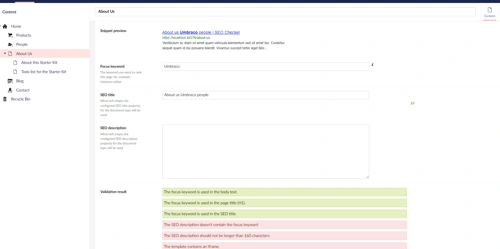
These plugins can automate SEO improvements and ensure your website follows best practices for search engine rankings.
Explore more tools and tips in our detailed blog post, Best tools for SEO optimization in Umbraco.
Other Useful SEO Tools for Umbraco Website Analysis and Monitoring
While Umbraco offers powerful built-in tools, third-party SEO platforms can help you monitor, analyze, and improve your site's SEO performance. Here are some essential tools to complement your Umbraco SEO strategy:
Google Search Console
Tracks your search performance, keyword rankings, and indexing issues, provides insights into Core Web Vitals and mobile usability, and helps identify and fix crawl errors and structured data issues.
Google Analytics (GA4)
Monitors user behavior, traffic sources, and engagement metrics, helps track conversion rates and goal completions, and provides insights into which content drives the most organic traffic.
Screaming Frog
Analyzes page structures, meta tags, and internal linking, detects broken links, duplicate pages, and redirect issues, and ensures on-page SEO elements are in place.
Semrush, Ahrefs, and Moz
Provide in-depth keyword research and backlink analysis, competitor SEO tracking and rankings, and high-performing content opportunities.
By using these tools with Umbraco, you can track SEO performance, find optimization opportunities, and stay ahead of the competition.
Umbraco Community and Resources for SEO Help
One of Umbraco’s strengths is its community, which is full of knowledge and resources. Here’s where you can find help and stay up to date with the latest Umbraco SEO trends:
Umbraco Community Forum
- Talk to experienced Umbraco developers and SEO experts.
- Get answers to technical SEO questions and best practices.
- Share your insights and learn from real-world case studies.
Umbraco Documentation
- Detailed guides on implementing SEO features.
- Technical SEO, metadata configurations, and performance optimization.
- Best practices and new features.
Umbraco Meetups & Conferences
- Attend Umbraco CodeGarden (the official conference) for the latest updates.
- Join local Umbraco user groups for networking and knowledge sharing.
- Watch recorded webinars on SEO and digital marketing topics.
Blogs and SEO Resources
- Follow Umbraco’s blog for SEO-related updates.
- Read insights from community members on platforms like ByteEditor’s blog.
- Case studies of real SEO success stories with Umbraco.
Umbraco Discord Channel
- Chat in real-time with fellow Umbraco enthusiasts, participate in discussions, and get quick answers to your queries.
UMB.FYI
- A weekly newsletter packed with concise updates, news, and events from the Umbraco ecosystem.
Conclusion: SEO Tools Make the difference
To compete in search today, your Umbraco website needs more than just great content. With the right plugins, analytics platforms, and support from the community, you’ll be well-equipped to climb the rankings.
Choose the SEO packages that fit your needs, combine them with a third-party tool to analyse, and continue learning from the Umbraco community.
Your Journey to Umbraco SEO Mastery
From understanding how search engines work with your CMS to structuring pages for maximum visibility and leveraging AI-ready content strategies, you’re now equipped with the knowledge and tools to turn your Umbraco website into a search engine success story.
SEO isn’t a one-time task, it’s an ongoing journey of testing, optimizing, and learning. With the right mindset, tools, and community behind you, you’re well on your way to building a future-proof, high-performing Umbraco site.
Ready to build an SEO-optimized Umbraco website?
Start now with ByteEditor
your partner for powerful, structured SEO.